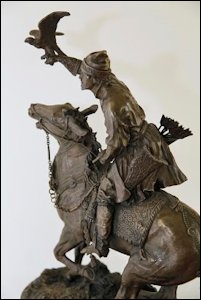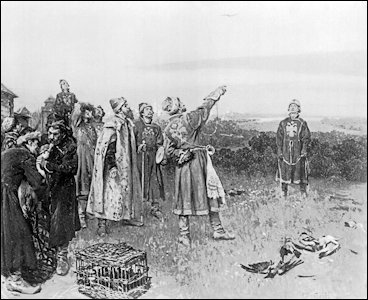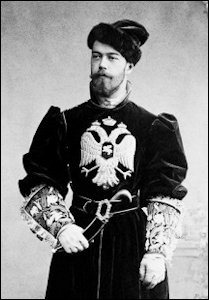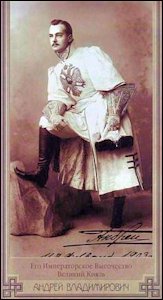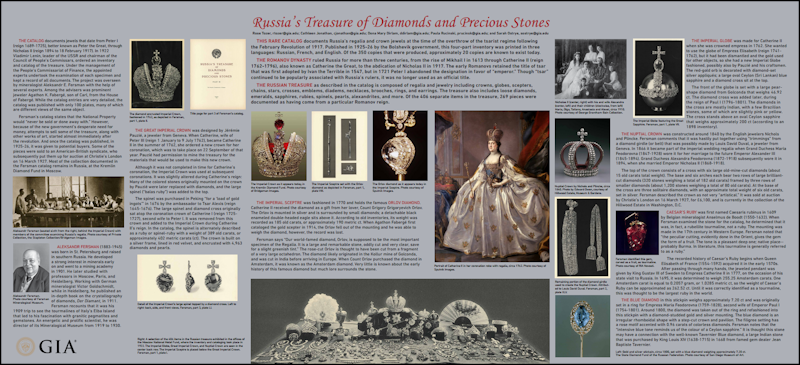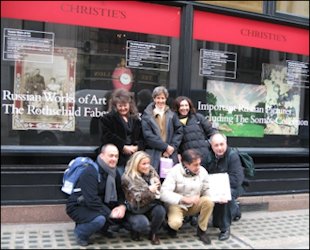
2007 London Fabergé Gathering
(Photograph John Jenkins)
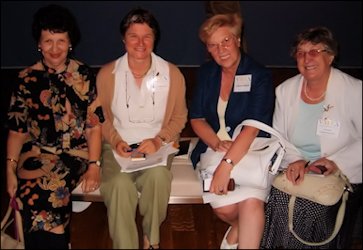
2011 Sympsosium Attendees from Russia in Richmond, Virginia
(McCanless Collection)
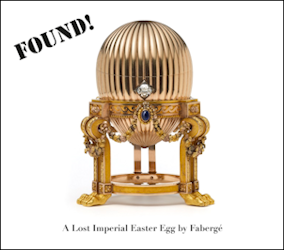
Missing 1887 Third Imperial Egg by Fabergé
(Courtesy Wartski)
Over 50 Fabergé enthusiasts from Finland, Netherlands, Russia, Switzerland, United Kingdom, and various parts of the United States met at the Virginia Museum of Fine Arts to participate in the opening events of the Fabergé Revealed exhibition in Richmond. It was a rare opportunity for collectors, Fabergé admirers, and scholars to meet – often for the first time – and to exchange information. A scholar’s day initiated by Géza von Habsburg was followed by a Fabergé enthusiasts gathering and a private viewing of a new installation of the Pratt and Russian Decorative Art Collections supplemented by loans from the Dan Hodges Collection, and the Artie and Dorothy McFerrin Collection. A highlight of the Richmond event was the announcement that a black and white photograph of the missing 1887 Fabergé Easter Egg had been found in an auction catalog. Three years later in 2014, the Imperial Fabergé egg was shown for a few days by Wartski’s in London. After the 2011 symposium a large contingent of the enthusiasts traveled to Hillwood Museum in Washington (DC) to view the Marjorie Merriweather Post Collection. The Fabergé Research Newsletter, Summer 2011 Special Edition, was published to commemorate the event.
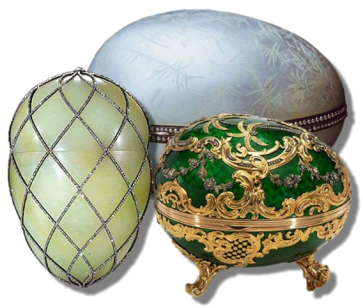
Diamond Trellis, Nobel Ice and Rosalie Eggs
in the McFerrin Collection
(Photo Collage by Annemiek Wintraecken)
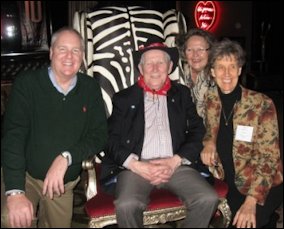
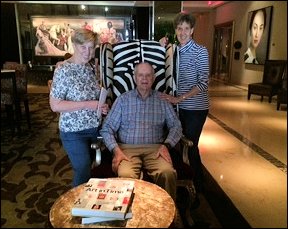
Celebrating Fabergé in Texas-Style in 2013 and 2016
(McCanless Collection)
Artie and Dorothy McFerrin and the Houston Museum of Natural Science hosted a Fabergé event gathering attended by 220 individuals. Speakers with recently published books included Tatiana Fabergé, Galina Korneva and Tatiana Cheboksarova, and Ulla Tillander-Godenhielm. Gems and Minerals in the McFerrin Collection, a power point presentation with an accompanying gem and mineral glossary presented by Christel McCanless, Annemiek Wintraecken, and Tim Adams set the stage for an afternoon of demonstrations by the Museum’s volunteers, known as the Rock Stars. Additional details about the event appeared in the Fabergé Research Newsletter, Winter 2012-2013.
October in 2014-2016 St. Petersburg, Russia
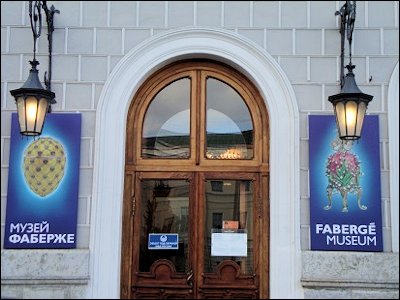
November 19, 2013 Fabergé Museum Opens in St. Petersburg, Russia
(McCanless Collection)
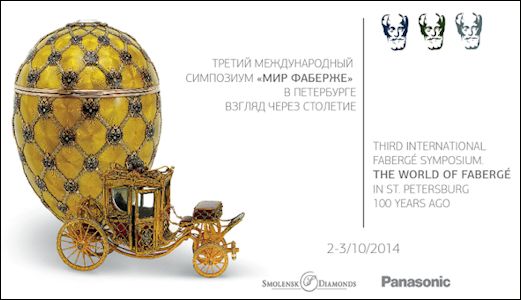
2014 Third International Fabergé Symposium
(Courtesy Riana Benko)
- 2014: The Fabergé Museum with support from the Neva Chapter of the Soroptimist International hosted the Third International Fabergé Symposium entitled, The World of Fabergé in St. Petersburg 100 Years Ago. An amazing job of co-operation for close to a year made this event and the subsequent issue of the Fabergé Research Newsletter, Fall 2014, possible. My thanks to one and all! A summary in English and Russian of the presentations was published. The authors of the presentation, Windows into Russian Life: Fabergé’s Hardstone Figures, have granted permission to share an illustrated summary of their talk in this newsletter. More …
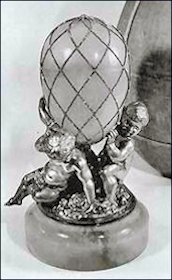
1892 Diamond Trellis Egg Missing
It’s Surprise with Putti Base,
Sotheby’s London, 1960
(Archival Photograph)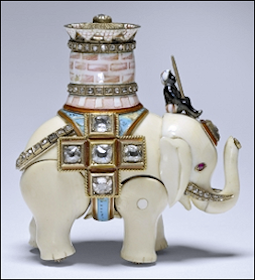
Found 2015! Missing Elephant Automaton Surprise
(Courtesy Royal Collection of Queen Elizabeth II)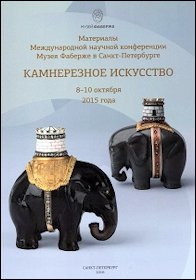
Symposium Presentation Summaries
(The Link of Times Cultural and
Historical Foundation, 2016) - 2015: The theme for the International Fabergé Museum Conference was Lapidary Art.
- Day One Proceedings
- Day Two Proceedings
- East Meets West: Russian Hardstones and the British Royal Collection, a public lecture by Caroline de Guitaut recorded as a video unveils the missing elephant automaton surprise.
- Galina Korneva and Tatiana Cheboksarova, Academic Editors, et al. Materials from the International Academic Conference at the Fabergé Museum in St. Petersburg: Lapidary Art, October 8-10, 2015 contains Russian and English summaries of the symposium presentations.

St. Petersburg Fabergé Symposium
(Courtesy Fabergé Museum) - 2016: The theme for the International Fabergé Museum Conference Celebrated the Life of Carl Fabergé (1846-1920)
- October 6, 2016 Proceedings in Russian
- October 7, 2016 Proceedings in Russian
- Riana Benko from Slovenia compiled Fabergé Symposium Summaries, St. Petersburg, 2016, in English.
2016 Houston, Texas: The Wonder of Fabergé: A Study of the McFerrin Collection
Fabergé enthusiasts from 7 foreign countries (Canada, Finland, France, Russia, Turkey, United Kingdom) and 9 American states totaling 181 persons participated in the recent Houston symposium, the second one in three years. Dr. Ulla Tillander-Godenhielm from Finland was the banquet speaker, followed by six scholarly in-depth presentations relating to objects in the McFerrin Collection. The presentation entitled, Fabergé Smoking Accessories: Materials and Techniques of an Art Form by Christel McCanless and Timothy Adams and its accompanying handout are available on the web as a teaching tool. During the afternoon demonstration session the Rock Stars, a volunteer group of the Houston Museum of Natural Science, had a hands-on session with materials and techniques used by the Fabergé firm. A second book about the McFerrin Collection was unveiled during the autograph event.
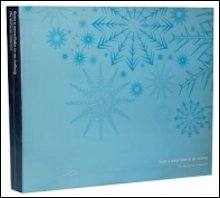
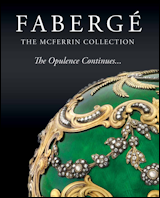
Fabergé: From a Snowflake to an Iceberg, 2013;
Fabergé: The McFerrin Collection – The Opulence Continues… 2016The McFerrin family sends a big “Thank You” to the presenters, the demonstrators, the Fabergé enthusiasts, and the museum staff for supporting the event. Our collection is for all to enjoy and we are happy to share information on any of the pieces.
Snapshots contributed by newsletter readers:
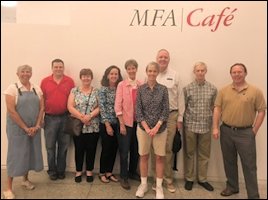
Newsletter Contributors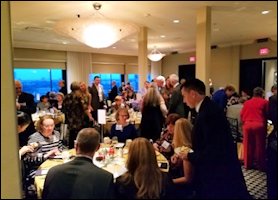
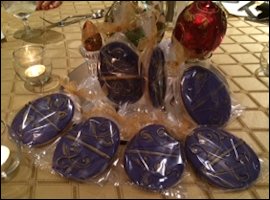
Banquet Celebration Complete with Fabergé Cookies
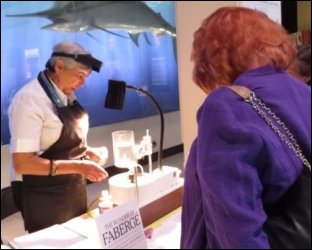
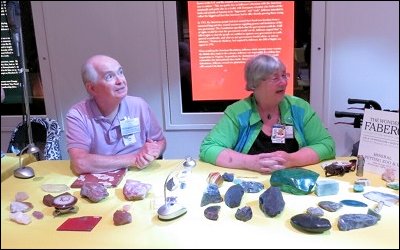
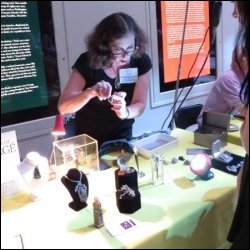
Rock Stars Teaching Materials & Techniques
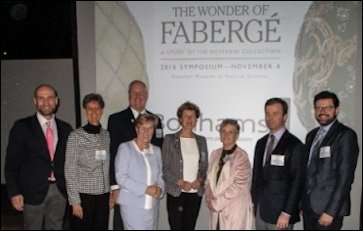
Symposium Presenters from Finland, Russia, USA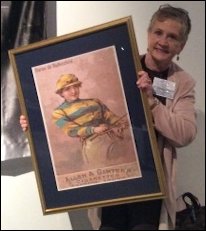
Dorothy McFerrin
Accepting Rothschild Poster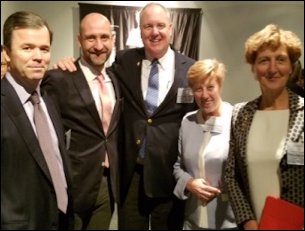
Congratulating Galina Korneva & Ulla Tillander-Godenhielm
for Attending Six Fabergé Symposiums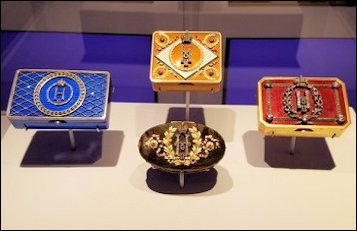
Imperial Snuff Boxes in the Exhibition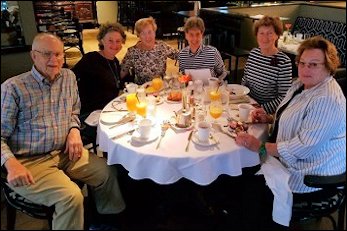
Final Breakfast Meeting
We Will Come Again to Ride
the Longhorn Shuttle!Mikhail Ovchinnikov, First Deputy Director of the Fabergé Museum, in an introductory essay for a recent exhibition of 80 Fabergé objects at the Russian Museum of Art in Minneapolis, Minnesota, reflects after three successful symposiums held in St. Petersburg:“On the one hand, it is quite gratifying when one is able to learn something new about the life and works of the famous jeweler. But on the other hand, the name expresses something that is very sad for anyone who searches for the truth: there are still too many gaps in our knowledge of Russian history and the art of the twentieth century.” (Unknown Fabergé: New Finds and Re-discoveries, 2016, 7-11)As editor of the Fabergé Research Newsletter, it is my hope the spirit of searching for the truth through worldwide symposiums, books, websites, newsletters and email contacts between collectors, enthusiasts and researchers will continue for a long time to come. The effort involved in planning a symposium anywhere in the world is not an easy task and we thank each and everyone who has lent a hand to make it happen in the last ten years!
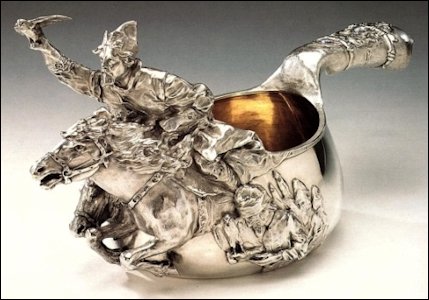
Fabergé Silver Falconer Kosvh
(21 in./53.3 cm)
(Courtesy Sotheby’s)
The design by Fabergé reflects inspiration from Evgenii Lanceray’s Fauconnier du tsar au XVlle siècle (Sokolinaya Ohota – Falcon Hunting) sculpted in 1872. Lanceray (1848-1886) exhibited a monumental version of his bronze sculpture at the All-Russian Industrial Art Exhibition in Moscow in 1882. It should be noted that the firm of Fabergé first participated in this event the same year and was awarded the gold medal. One of the sculptor’s three large scale versions (now at the Azerbaijan State Museum of Art, Baku) was transferred from St. Petersburg to Baku in 1926 to be installed at the Absheron Sanatorium, near where the Nobel family often stayed, at the end of the 19th century, in their dacha on the peninsula. Identical casts of this sculpture found their way to Menton, France, and the USA, location unknown. Images found for ‘Menton Alpes Maritimes, Le Parc, La Chasse au Berkout, Eugene Lanceray illustrate two variations (A & B below). These sculptures stand at the entrance of the Jardins Biovès; the second image is comparable to the Nobel kovsh.
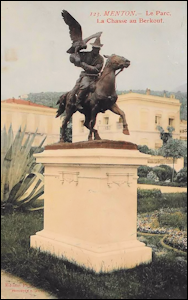
A. Postcard, Menton Alpes Maritimes,
Le Parc, La Chasse au Berkout
(Purchased at akpool)
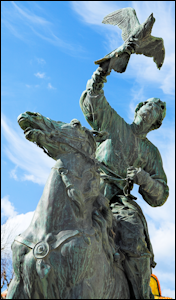
B. The Russians on the
Côte d’Azur – Menton
(Purchased at Shutterstock)
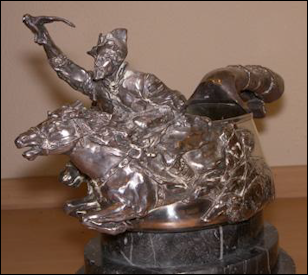
The Tsar’s Cup (Tsarscaia) Farnese Regiment Madrid, Spain
(Romanov News, #96, 2016, 81)
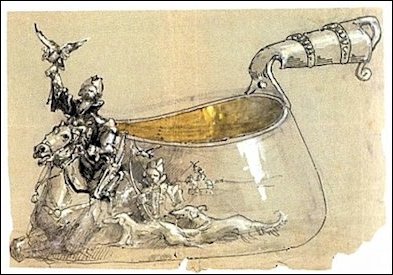
Unidentified Kovsh Sketch
(Fabergé, Tatiana F., et al. Fabergé: A Comprehensive Reference Book, 2012, 349)
As explored in the previous newsletter segments, the Bogatyr themes of the kovshes, had deep roots in Russian history and their expression through the Russian Decorative Arts during the period of the Fabergé firm’s operation. The theme of the ‘Falconer’ is no exception to this trend. The falcon hunt was a favorite entertainment of the nobility in medieval Russia, most especially by the Boyars, the highest rank in feudal aristocracies.
Themes in Russian Art and Culture
Klavdy Lebedev’s (1852-1916) painting Testing the Falcons depicts 17th century boyars and their falconers near the village of Kolomenskoye. Lebedev was a member of the Peredvizhniki or ‘Wanderers’ a group of Realist artists who broke away from the Imperial Academy of Arts in 1863. There, he found himself in the company of Serov, Repin, and Viktor Vasnetsov (painter of the epic canvas, The Bogatyrs, Tretyakov, Moscow). Konstantin Makovsky was also a member of this group, and it should be noted that his Boyar Wedding Feast canvas (Hillwood Museum, Washington, D.C.) was painted in the same year (1883) as Lebedev painted his Boyar Wedding (Tretyakov, Moscow).
Before our falcon is freed of its hood for the final flight of this series, I would like to include one last genre illustrating the falcon in Russian culture and art. While there are many illustrators of Russian fairytales, surely Ivan Bilibin (1876-1942) ranks among the most recognized and celebrated. One of my personal best loved of these fairytales illustrated by Bilibin is the tale of ‘Finist the Falcon’.
This beguiling tale, is replete with the signature poor laboring father with three daughters, (the eldest vain and selfish, and the youngest simple and good) the witch Baba Yaga, sleeping-spells, and of course a romantic and mysterious shape-shifting prince!
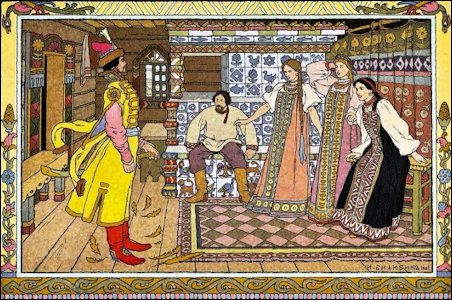
Finist the Falcon by Ivan Bilibin
(Courtesy Wikimedia)
2 Fabergé’s Monumental Silver Kovshes with Bogatyr Themes, Part II by Cynthia Coleman Sparke
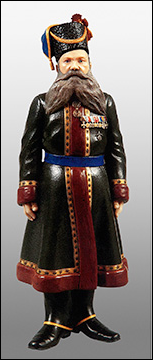
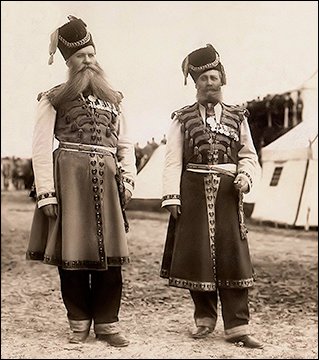
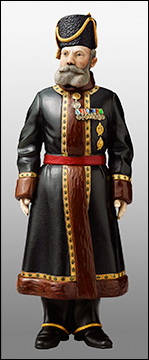
Left and right: The Fabergé hardstone figure of Chamber Cossacks A.A. Kudinov, who guarded Empress Maria Feodorovna
from 1878 to 1915, and N.N. Pustynnikov, who served Empress Alexandra Feodorovna from 1894 until 1917.
(Photographs Courtesy of Pavlovsk State Museum (left) and Wartski, London (right).
Center: Archival photograph of Kudinov and Pustynnikov in their ceremonial dress at annual military
maneuvers presided over by Nicholas II in 1913.
(Photographs Courtesy of Sammler.ru)
Between 1908 and 1916, the workshops of the Russian court jeweler Carl Fabergé created approximately 50 hardstone figures representing the Russian people, including peasants, merchants, noblemen, and soldiers. Made from gems and precious metals, they are as rare as the well-known Imperial Easter eggs. The last Romanov emperor, Nicholas II, owned 21 of these portrait figures, two of which depict the Cossack bodyguards of the Romanov empresses. This article examines the hardstone figures through known biographical details, archival photographs of the Chamber Cossacks Kudinov and Pustynnikov, an original production sketch, and an invoice from the Fabergé firm. It discusses the creation of the pieces from gemstones and minerals mined in Russia. More Gems & Gemology, Summer 2016, Vol. 52, No. 2, pp. 132-143.
The authors wish to thank military medals experts Daniel Brière and Erich Lenz for sharing additional research below on the medals awarded to the two Chamber Cossacks.
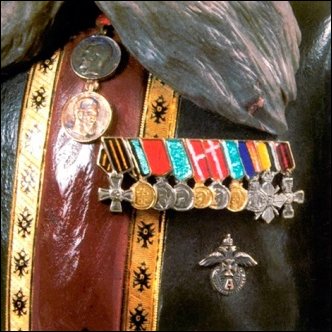
Close-up of Kudinov’s badges and medals
(Photo Courtesy of Pavlovsk State Museum)
Medals on Kudinov’s chest (left to right):
- The Insignia of Distinction of the Military Order of St. George, 4th class. Awarded on May 24,1878, for valor and bravery. Silver cross on an orange and black St. George ribbon.
- To Commemorate the Russo-Turkish War 1877- 1878. Light bronze medal on a combined ribbon of St. George and St. Andrew.
- Alexander III Commemorative Medal 1896. Silver on a red St. Alexander Nevsky ribbon.
- Coronation of Nicholas II Commemorative Medal 1896. Silver on light blue St. Andrew ribbon.
- Danish Medal of Merit. Awarded in 1895 by King Christian IX (1863-1906). Gold on a red ribbon with white cross.
- Danish Medal of Merit. Awarded by King Christian IX (1863-1906). Silver on a red ribbon with white cross.
- Gold or Bronze medal on a light blue ribbon edged in white: probably the bronze Medal for Merit from Mecklenburg Schwerin (1907-1918).
- Romanian Medal for Defense of Freedom, 1877-1878. Silver on a dark blue ribbon with red and gold edge.
- Bulgarian Order of Military Merit, 6th class. Silver cross with swords on a yellow ribbon with black and white edge.
- Romanian Trans-Danube Cross (1878). Cross on a red/black/red ribbon.
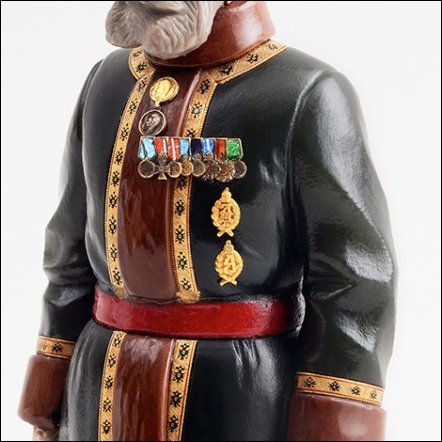
Close-up of Pustynnikov’s badges and medals
(Photograph © Wartski, London)
Detail for the golden chest badge (top) awarded for service in one of “His Majesty’s Squadron” during the reign of Alexander II (the 1st squadron of a regiment which had the emperor as colonel-in-chief).
Detail for the golden chest badge (bottom) awarded for service in one of “His Majesty’s Squadron” during the reign of Alexander III.
Medals on Pustynnikov’s Chest (left to right):
- Coronation of Nicholas II medal (May 26, 1896). Silver on a light blue ribbon.
- Hesse-Darmstadt’s Cross of the Order of Philippe the Magnanimous (December 25, 1899). Silver on a red ribbon edged in light blue.
- Danish Medal of Merit or Royal Medal of Recompense. Silver on a red ribbon with a white cross.
- Prussian Medal of the Order of the Crown (December 25, 1899). Gilt bronze on a blue ribbon.
- Romanian Loyal Service Medal, 2nd class. Silver on blue ribbon with white edge.
- French Colonial Order of the Light (Nichan al Anuar), 5th class. Silver-gilt star on blue ribbon with white stripe in the middle.
- Turkish Order of the Medjidie, 5th class (June 1, 1903). Silver star on a red ribbon edged in green.
- Persian medal, probably a medal of the Order of the Lion and the Sun. Silver on a green ribbon. The two golden (bronze) chest badges below the medal bar show Pustynnikov served in the companies and squadrons of Emperors Alexander II (top badge) and Alexander III (lower badge).
- Persian medal, probably a medal of the Order of the Lion and the Sun. Silver on a green ribbon.
After the closing of the current Fabergé exhibition at the museum on January 8, 2017, a new Artie and Dorothy McFerrin Gallery with a rotating Fabergé collection will be unveiled and opened to the public on April 10, 2017. The highlight of the new exhibition (for a limited time only) will be the 1892 Diamond Trellis Egg reunion with its surprise, an automaton elephant from the Collection of Queen Elizabeth II.
Special events:
April 5, 2017 6:30 – 8:00 pm Lecture by Caroline de Guitaut, Senior Curator, Royal Collection
April 7-9, 2017 Open to Museum Members ONLY
Minneapolis, Minnesota – The Museum of Russian Art, Minneapolis (MN)
Fabergé: An Intimate View of Rarely Seen Pieces by Tim Adams
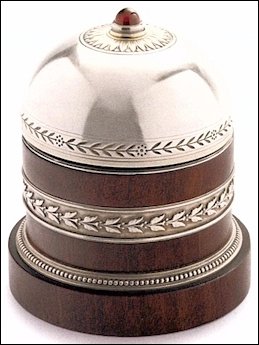
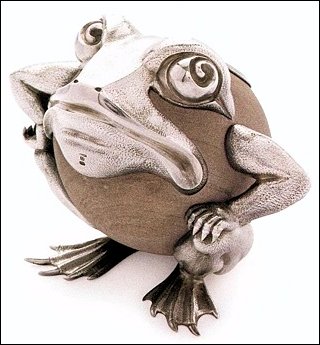
Silver and Palisander Wood Imperial Bell Push by Nevalainen;
Silver and Sandstone Vesta Holder and Strike by Rappoport (Courtesy TMORA);
Images of the Exhibition (Courtesy Mark Moehrke)
An unusual piece I found fascinating is a wood and silver bell push from the James Hurtt Collection. Unusual because it was mechanical, not electric as most Fabergé bell pushes, so it could be used on a veranda without electrical outlets. Mr. Hurtt recognized his piece in a photograph of Nicholas II and Grand Duchess Elizabeth partaking tea at Peterhof. A silver and sandstone frog match holder lent by Wartski of London made me smile as soon as I saw it. Its whimsical style is a Fabergé trade mark to delight the viewer at first sight. The exhibition showcasing many objects never before exhibited in public presents the wide variety of Fabergé’s work: clocks, jewelry, picture frames, icons and even a rhinoceros automaton. From the whimsical to the sublime, there is something in this temporary exhibition for everyone to enjoy.
New York City – Metropolitan Museum of Art
The Matilda Geddings Gray Collection on view at the museum for the last five years will be extended for another five years. The museum recorded 6.7 million visitors in 2015.
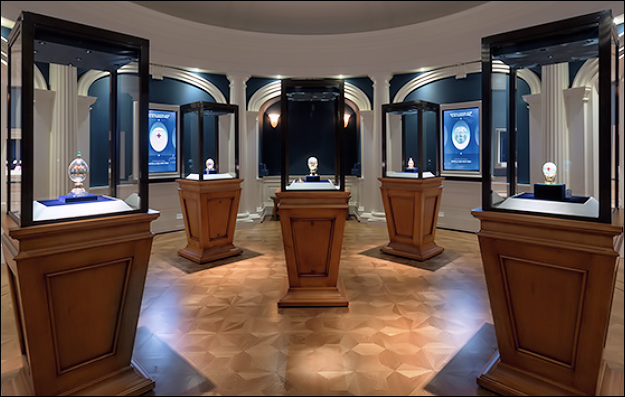
VMFA Fabergé and Russian Decorative Arts, Imperial Easter Eggs Gallery
(Photo: Travis Fullerton © Virginia Museum of Fine Arts)
- “Five Pathways” allows users to explore the collection through various historical perspectives. The Romanovs, Fabergé and his workmasters, and Mrs. Pratt are all featured, along with never-before seen photographs and archives.
- “Create Your Own Fabergé Eggs” allows users to select design features from the mini-eggs to create a custom egg design. The designs can be emailed to users with information on the selected eggs, and they can be saved and “liked” by other visitors/users.
- “The Tale of Ivan and the Gray Wolf” features a retelling of the classic Russian fairytale through an interactive map of the narrative. The beautiful artwork was carefully cut from VMFA’s rare copy of Ivan Bilibin’s illustrations.
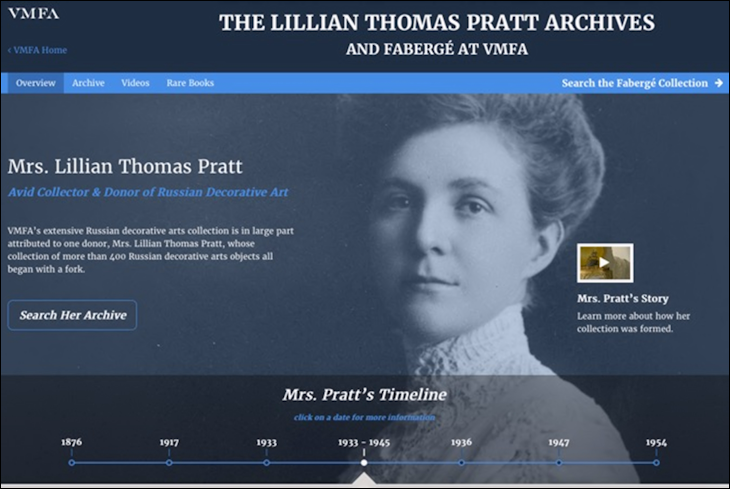
Lillian Thomas Pratt Archives and Fabergé
- The digitized archive is comprised of correspondence, invoices, price tags, and detailed item descriptions, all of which illuminates Mrs. Pratt’s mind as a collector, as well as the close relationship she formed with New York based art dealers Alexander and his wife Ray Schaffer, owners of A La Vieille Russie.
- The videos include newly filmed footage of the Imperial Easter Eggs opening, interactive 360° views of the eggs, and documentary material about Mrs. Pratt and her collection.
- Two newly digitized rare books are available on the website, including the 1883 Coronation Album of Tsar Alexander III and Empress Maria Feodorovna and “The Tale of Ivan and the Gray Wolf” illustrated by Ivan Bilibin.
- The site also includes links to downloadable teacher resources, including a Creative Tool Kit featuring specially selected archival material that investigates the economics of collecting Fabergé decorative art. The kit is designed to challenge students’ math skills, logic skills, historical knowledge, creativity, and to utilize the Pratt archive in a totally new way.
Finally, four large touch-screens will replace traditional didactic panels in the Imperial Easter Egg Room. These touchscreens will feature didactic information, detail views, and the newly filmed videos of the eggs opening with their surprises.
- The Fabergé Museum recently added the archives of Henry C. Bainbridge, manager of the London Fabergé branch from 1904-1917.
- The Mining Museum had two special visitors.
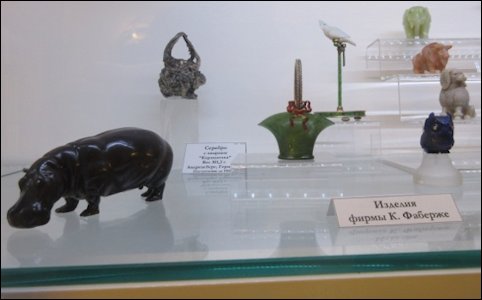
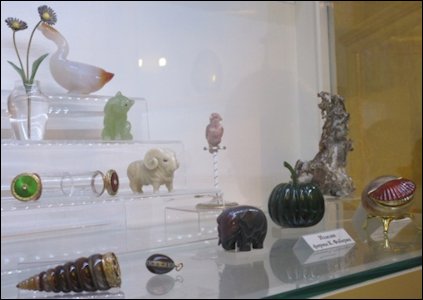
Fabergé Objects in the Mining Museum
(Courtesy Cynthia Coleman Sparke)
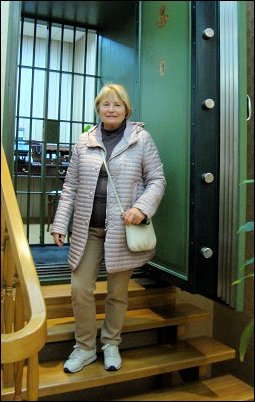
Fabergé Safe at Bolshaya Morskaya,
St. Petersburg Russia
(Courtesy Riana Benko)
Ms. Sparke shared photographs of Fabergé objects from her visit. Ms. Benko wishes to thank Elena Popova, the director, “for her willingness to guide me individually through the museum”. It was special treat indeed! During a visit to the Fabergé shop at 24 Bolshaya Morskaya Street, she saw the former private office of Carl Fabergé and the firm’s safe.
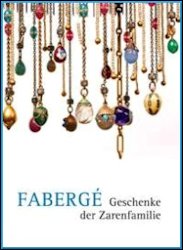
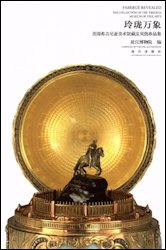
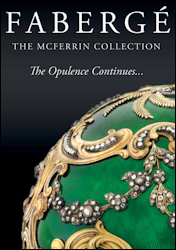
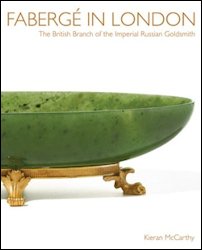
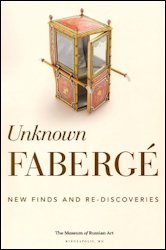
(Courtesy of the Authors)
The exhibition (Fabergé – Gifts from the House of Romanov) illustrates the connection of the Russian Imperial Family to German principalities using the children of the Grand Duke Ludwig IV of Hesse and by the Rhine and his wife Alice, born princess of Great Britain, as examples. Consequently, it does not only focus on the work of Fabergé, but also on the life stories of the givers and recipients. The personalities involved are introduced to the visitors through contemporary photos, selected portraits and personal items. Book and review of the venue in German.
Fabergé Revealed: The Collection of the Virginia Museum of Fine Arts Compiled by the Palace Museum. Forbidden City Publishing House, 2016. An exhibition catalog for 234 objects which traveled from the Richmond, Virginia, to Beijing, China, for a temporary exhibition from April to July 2015. In English and Chinese with colored illustrations for each object.
Fabergé: The McFerrin Collection – The Opulence Continues… 2016
Unveiled at the 2016 Houston Fabergé symposium, the second volume for the McFerrin Collection illustrates and describes via subject categories a large portion of the 600 objets d’art acquired since 2005. Imperial award objects and those detailed in the previous book, From a Snowflake to an Iceberg: The McFerrin Collection, 2013, are denoted along with indexes by subjects and original owners for both publications.
McCarthy, Kieran. Fabergé in London: The British Branch of the Imperial Russian Goldsmith, 2017.
The first book dedicated to the British branch of Fabergé covers fascinating history from its opening in 1903 to its closure in 1917. London’s Fabergé branch manager, Henry Bainbridge’s private archive, was recently donated to the Fabergé Museum in St. Petersburg. McCarthy’s book based on the archive yields detailed information about the daily activities of Fabergé in London and also in Russia, and contains a daybook Bainbridge carried everywhere noting what was going on around him as well as a brief diary for 1908. There are also rafts of letters by him and primarily Eugène, Fabergé’s first son, discussing the firm’s customers, employees, techniques, and philosophy. The relationship between the Bowe and Fabergé families, and the activities of Agathon Fabergé, second son of Carl Fabergé, revealed by the archives fill a gap which has existed far too long time for serious Fabergé scholars.
Moehrke, Mark, Editor. Unknown Fabergé: New Finds and Re-Discoveries, 2016.
More than 80 Fabergé objects in the context of their personal story or role in the life of society at that time are discussed in the exhibition catalog published by the Museum of Russian Art, Minneapolis (MN). Essays also by Mikhail Ovchinnikov, Marilyn Swezey, Mark Moehrke, and Ulla-Tillander-Godenhielm.
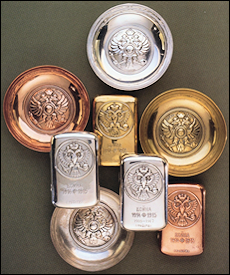
Fabergé’s War Production
(Traina, John. The Fabergé Case from the
Private Collection of John Traina, 1998, 148)
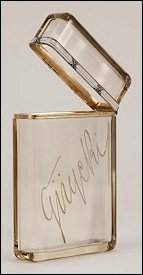
Quartz Cigarette Case
(Courtesy McFerrin Collection)
- Were the objects sold to raise money for charity or given as gifts to soldiers and officers by the Emperor?
- Are the white metal bowls and cases, silver, steel, or aluminum? Or did they come in all three metals, the silver ones being reserved for higher ranking recipients? During the World War I, silver would have been in rare supply. Steel was used in the Imperial 1916 Steel Military Egg.
- An archival photograph exists with the Emperor Nicholas II presenting a war production item to a soldier. If known, please share.
Can anyone decipher the language and text on this smoky quartz cigarette case? Contact: Tim Adams
Barbara Miller, a new Fabergé Research Newsletter reader:
- “Diamond Geezer”, Antiques Trade Gazette, July 26, 2016, 34-36. Dealer’s Diary Interview features Geoffrey Munn. (Courtesy John Jenkins)
- Geoffrey Munn’s discovery on the Antiques Roadshow (Courtesy Roy Tomlin)
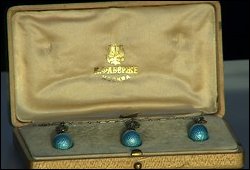
Discovery of a Fabergé necklace with sky blue
pendant eggs in an original hollywood
case valued at 12,000 GBP.
GIA unveiled a poster (8 ft x 4 ft) at the October Geological Society of America (GSA) Annual Meeting to announce the digitized Fersman Portfolio. A bibliography accompanied the project. An article, Fersman Portfolio and Nuptial Crown Review, was published in the Fabergé Research Newsletter, Summer and Fall 2016.



















